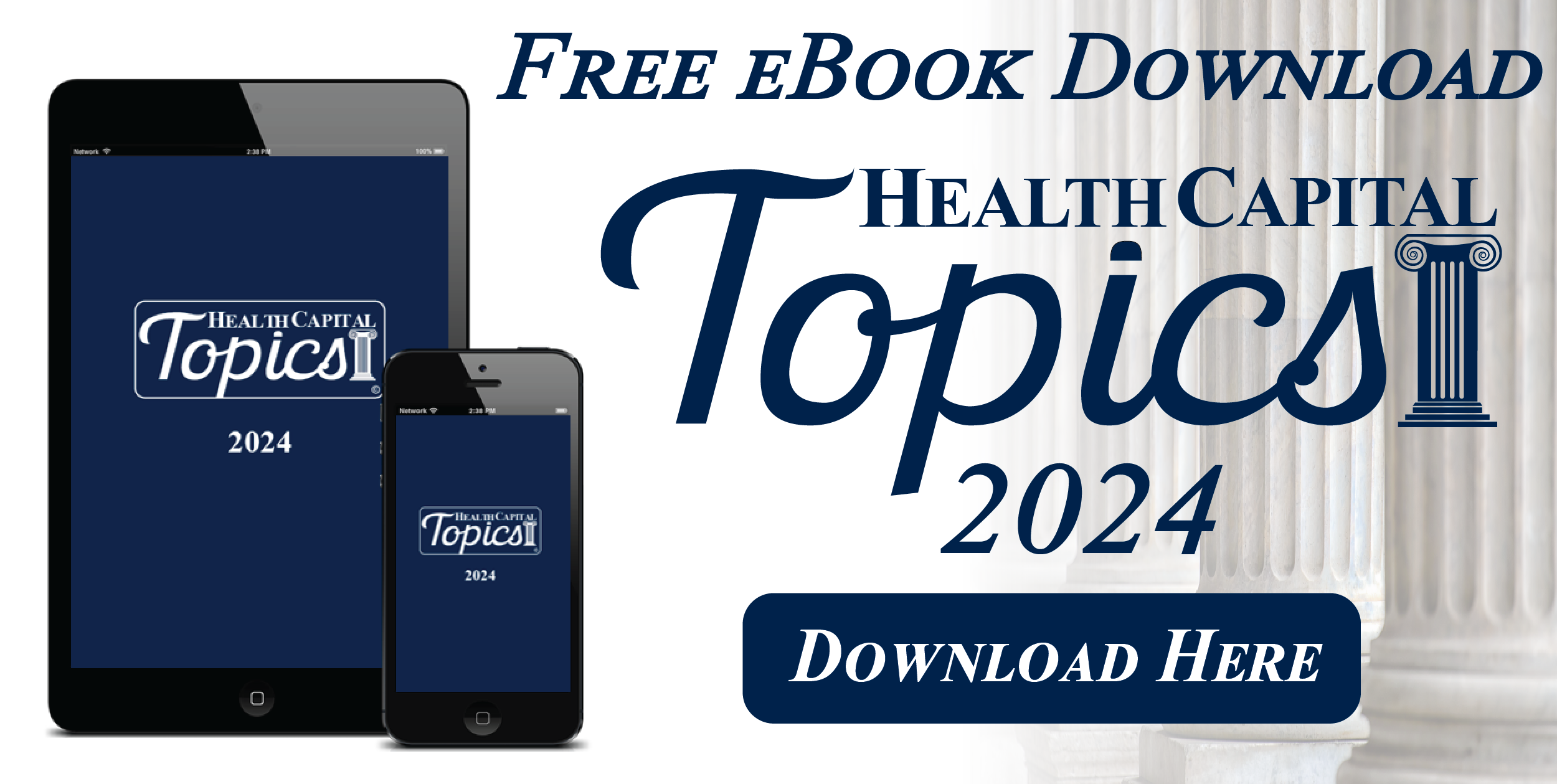On April 11, 2025, the Centers for Medicare & Medicaid Services (CMS) released its proposed rules for the payment and policy updates for the Medicare inpatient prospective payment system (IPPS) and long-term care hospital prospective payment system (LTCH PPS) for fiscal year (FY) 2026.1 This Health Capital Topics article will discuss the proposed rule and the implications for stakeholders.
By law, CMS is required to update IPPS and LTCH payment rates annually while accounting for changes in the prices of goods and services used by hospitals in the treatment of Medicare beneficiaries.2 Under the two payment systems (IPPS and LTCH PPS), base payment rates are set by CMS prospectively for inpatient stays based on the severity of the illness, the services utilized, the treatment provided, the cost of labor in the locality, and the patient’s diagnosis.3 Hospitals receive a lump payment for each hospitalization, dependent on the Diagnosis-Related Group (MS-DRG) classification assigned at discharge.4
CMS proposes increasing the IPPS base rate by 2.4%, which amounts to $4 billion in additional funding for FY 2026.5 This percentage increase is comprised of a projected FY 2026 hospital market basket increase of 3.2%, reduced by a 0.8% productivity adjustment.6 This proposed increase is lower than the FY 2024 payment increase of 2.9%.7 For FY 2026, the LTCH standard payment rate is expected to increase by 2.6%, based a projected FY 2026 LTCH PPS market basket increase of 3.4%, reduced by a 0.8% productivity adjustment.8 For FY 2025, the LTCH PPS payments increased by 3.0%.9 CMS expects payments for LTCH discharges paid the standard rate to increase approximately $52 million, or 2.2%, due to the 2.6% update and a projected decrease (0.3%) in high-cost outlier payments as a portion of all LTCH PPS payments.10 Additionally, CMS proposes to again increase the LTCH outlier threshold for FY 2026 to comply with statutory requirements that outlier payments may only comprise a certain proportion of total payments.11
Included in the proposed rule are requests for information (RFIs). One of the RFIs focuses “on approaches and opportunities to streamline regulations and reduce burdens on those participating in the Medicare program.”12 Released in response to a January 2025 Executive Order calling for federal agencies to eliminate at least 10 prior regulations for each new regulation issued,13 CMS asks commentators for answers in response to questions including:
-
“Are there existing regulatory requirements---that could be waived, modified, or streamlined to reduce administrative burdens without compromising patient safety or the integrity of the Medicare program?”
-
“Which specific Medicare administrative processes or quality and data reporting requirements create the most significant burdens for providers?”
-
“Are there specific Medicare administrative processes, quality, or data reporting requirements, that could be automated or simplified to reduce the administrative burden on facilities and providers?”
-
“Are there opportunities to reduce the frequency or complexity of reporting for Medicare providers?”
-
“How can Medicare better align its requirements with best practices and industry standards without imposing additional regulatory requirements, particularly in areas such as telemedicine, transparency, digital health, and integrated care systems?”14
The proposed rule also includes updates to the mandatory episode-based Transforming Episode Accountability Model (TEAM) that is set to take effect on January 1, 2026,15 and aims to improve “quality of care for people with Medicare undergoing certain high-expenditure, high-volume surgical procedures [such as joint replacements, bowel surgeries, and spinal fusions], reducing rehospitalization and recovery time while lowering Medicare spending and driving equitable outcomes.”16 Proposed updates include adding new participant hospitals, revising quality metrics and pricing methodology, and eliminating certain reporting elements.17
Healthcare industry stakeholders expressed frustration with CMS’s proposals, arguing that the proposed payment increase is insufficient. The American Hospital Association (AHA) expressed its disappointment that CMS
“proposed an inadequate inpatient hospital payment update…including of particular concern an extremely high proposed productivity cut….We are very concerned that this update will hurt our ability to care for our communities. Indeed, many hospitals across the country, especially those in rural and underserved communities, already operate under unsustainable financial situations, including negative margins. We urge CMS to reconsider its policy in the final rule to enable all hospitals to provide high-quality, around-the-clock, essential care for their patients and communities.”18
The Federation of American Hospitals (FAH) issued a similar statement, asserting that “the reality is that patient care still faces the twin problems of hangover cost increases from hyperinflation and the cumulative effect of inadequate payment over time from Medicare and Medicaid.” Alluding to the spending bill currently working its way through Congress, which includes over $716 billion in Medicaid cuts (the largest in program history),19 FAH went on to state that it is “mission critical Congress protects Medicaid coverage by avoiding funding cuts...”20
Notwithstanding the payment update criticism, the AHA expressed appreciation for the RFI on streamlining regulations and reducing burdens for providers, given that “America’s hospitals and health systems spend too many resources each year on regulatory requirements, forcing many of our clinicians to focus more time completing paperwork than treating patients.”21
Comments are due to CMS by June 10, 2025, and the final rule is expected to be published on or about August 1, 2025.22
“FY 2026 Hospital Inpatient Prospective Payment System (IPPS) and Long-Term Care Hospital Prospective Payment System (LTCH PPS) Proposed Rule — CMS-1833-P Fact Sheet” Centers for Medicare & Medicaid Services, April 11, 2025, https://www.cms.gov/newsroom/fact-sheets/fy-2026-hospital-inpatient-prospective-payment-system-ipps-and-long-term-care-hospital-prospective (Accessed 5/22/25).
“FY 2025 Hospital Inpatient Prospective Payment System (IPPS) and Long-Term Care Hospital Prospective Payment System (LTCH PPS) Final Rule –- CMS-1808-F” Centers for Medicare & Medicaid Services, August 1, 2024, https://www.cms.gov/newsroom/fact-sheets/fy-2025-hospital-inpatient-prospective-payment-system-ipps-and-long-term-care-hospital-prospective-0 (Accessed 5/22/25).
FY 2026 Proposed Rule — CMS-1833-P Fact Sheet” Centers for Medicare & Medicaid Services, April 11, 2025.
“FY 2024 Hospital Inpatient Prospective Payment System (IPPS) and Long-Term Care Hospital Prospective Payment System (LTCH PPS) Final Rule — CMS-1785-F and CMS-1788-F Fact Sheet” Newsroom, Centers for Medicare and Medicaid Services, August 1, 2023, https://www.cms.gov/newsroom/fact-sheets/fy-2024-hospital-inpatient-prospective-payment-system-ipps-and-long-term-care-hospital-prospective-0 (Accessed 4/19/24).
“FY 2026 Proposed Rule — CMS-1833-P Fact Sheet” Centers for Medicare & Medicaid Services, April 11, 2025.
“Unleashing Prosperity Through Deregulation” Executive Order 14192, Federal Register Vol. 90, No. 24 (January 31, 2025), available at: https://www.govinfo.gov/content/pkg/FR-2025-02-06/pdf/2025-02345.pdf (Accessed 5/22/25), p. 9065-9067.
“CMS issues hospital IPPS proposed rule for FY 2026” American Hospital Association, April 11, 2025, https://www.aha.org/news/headline/2025-04-11-cms-issues-hospital-ipps-proposed-rule-fy-2026 (Accessed 5/22/25).
“The next generation of Medicare bundled payments: Considerations regarding TEAM” By Alyssa Pennini, et al., Milliman, May 12, 2025, https://www.milliman.com/en/insight/next-generation-medicare-bundled-payments-considerations-team (Accessed 5/22/25).
“Cheat Sheet: FY 2026 Inpatient Prospective Payment System (IPPS) Proposed Rule” CHiME, April 23, 2025, https://chimecentral.org/resource-post/cheat-sheet-fy-25-ipps-proposed-rule (Accessed 5/22/25).
American Hospital Association, April 11, 2025.
“By the Numbers: House Bill Takes Health Coverage Away From Millions of People and Raises Families’ Health Care Costs” Center on Budget and Policy Priorities, May 21, 2025, https://www.cbpp.org/research/health/by-the-numbers-house-bill-takes-health-coverage-away-from-millions-of-people-and (Accessed 5/22/25).
“FAH Statement on CMS Proposed Rules for Fiscal Year 2026” Federation of American Hospitals, April 11, 2025, https://www.fah.org/blog/fah-statement-on-cms-proposed-rules-for-fiscal-year-2026/ (Accessed 5/22/25).
American Hospital Association, April 11, 2025.
“CMS Releases Fiscal Year 2026 IPPS and LTCH Proposed Rule” By Miranda A. Franco and Sarah Starling Crossan Holland & Knight, April 24, 2025, https://www.hklaw.com/en/insights/publications/2025/04/cms-releases-fiscal-year-2026-ipps-and-ltch-proposed-rule (Accessed 5/22/25).





